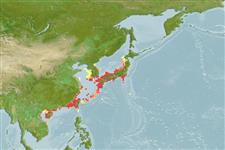分類 / Names
俗名 | 同種異名 | Catalog of Fishes(屬, 種) | ITIS | CoL | WoRMS | Cloffa
Teleostei >
Eupercaria/misc (Various families in series Eupercaria)
鱸形目 (Various families in series Eupercaria) >
Labridae (Wrasses)
隆頭魚科 (Wrasses)
Etymology: Pseudolabrus: Greek, pseudes = false + Greek, labrax = a fish, Dicentrarchus labrax (Ref. 45335); japonicus: Specific epithet refers to the country of origin of Houttuyn's type specimens..
Environment: milieu / climate zone / depth range / distribution range
生態學
海洋 礁區魚類. 熱帶
Northwest Pacific: central Honshu to Okinawajima in Japan; South Korea, southern China, Taiwan, and Hong Kong.
西北太平洋: 在日本的本州中部到沖繩島; 南韓,中國南部,台灣與香港。
大小 / 重量 / 年齡
Maturity: Lm ? range ? - ? cm
Max length : 25.0 cm TL 雄魚/尚未辨別雌雄; (Ref. 559)
Retires under low rock ledges at night. Feeds mainly on small benthic organisms (small crustaceans, mollusks and polychaete worms, sponges, coral polyps). Hibernates in the sand in winter.
在低的岩石岩架下面退隱在晚上。 主要吃小型底棲的生物。 (小型甲殼動物, 軟體動物與多毛類的蠕蟲,海綿, 珊瑚蟲) 過冬在砂中冬天時。
Life cycle and mating behavior
Maturities | 繁殖 | Spawnings | Egg(s) | Fecundities | 仔魚
Pelagic spawner.西北太平洋: 在日本的本州中部到沖繩島; 南韓,中國南部,台灣與香港。
Russell, B.C., 1988. Revision of the labrid fish genus Pseudolabrus and allied genera. Rec. Aust. Mus. (Suppl. 9):1-72. (Ref. 26203)
人類使用
漁業: 商業性; 水族館: 商業性
工具
特別的報告
下載 XML
網路資源
Estimates based on models
Preferred temperature (Ref.
123201): 17.6 - 26.9, mean 22.8 °C (based on 267 cells).
Phylogenetic diversity index (Ref.
82804): PD
50 = 0.5002 [Uniqueness, from 0.5 = low to 2.0 = high].
Bayesian length-weight: a=0.01995 (0.00922 - 0.04317), b=2.99 (2.79 - 3.19), in cm total length, based on LWR estimates for this (Sub)family-body shape (Ref.
93245).
營養階層 (Ref.
69278): 3.1 ±0.35 se; based on food items.
回復力 (Ref.
120179): 中等的, 族群倍增時間最少 1.4 - 4.4年 (Preliminary K or Fecundity.).
Fishing Vulnerability (Ref.
59153): Low vulnerability (15 of 100).
